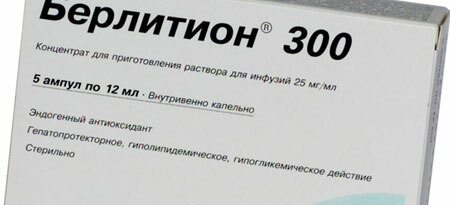Neurology often has a wide variety of symptoms, called "focal neurological symptoms."This means that some misfortune has occurred with one or more functions of the central or peripheral nervous system.
An example of focal symptomatology may be weakness and tremor in the upper or lower limbs, facial paralysis, increased tendon reflexes, and so on.
But there is a term that combines the defeat of many nerves, but they are, as a rule, most remote from the central nervous system and located on the periphery. Let's try to explain this tricky and vague definition of "polyneuropathy" in simple words.
Contents
- 1 Polyneuropathy - what is it?
- 2 Symptoms of polyneuropathy - characteristic signs
- 3 Diagnosis of polyneuropathy
- 4 Treatment of polyneuropathy, preparations
Polyneuropathy - what is it?

Polyneuropathy - is translated from Greek as "the suffering of many nerves".These nerves can be affected by external factors that affect them for a long time and disrupt the functioning. Unlike a brain tumor or stroke, which causes a strictly defined set of symptoms depending on the location, polyneuropathy reveals a special clinical picture, which will be discussed below.
First of all, polyneuropathy is caused by diseases in which any substances harmful to the nerves accumulate in the body. Such diseases include endocrine pathology and diabetes mellitus.
The high blood glucose level, which lasts a long time, contributes to impaired conduction of the peripheral nerves. As a result, diabetic polyneuropathy arises. It belongs to the group of dysmetabolic disorders.
If the cause of the disease is not the usual substance( because glucose is in the blood of everyone, just when there is too much diabetes), and any external toxin, then there is a toxic damage to the peripheral nerves, both sensitive and motor.
This is how the toxic damage of the peripheral nerves develops, and the most striking example is alcoholic polyneuropathy, which arises in people who are strong and long drinking.
Malignant neoplasms that poison the entire body with products of their vital activity and disintegration can also cause nerve damage. Such polyneuropathy is called paraneoplastic, and it is a formidable sign of a launched oncological disease.
Sometimes serious infections cause nerve damage. Such polyneuropathy can be attributed to both infectious and toxic - because microorganisms often use the strongest toxins, for example, diphtheria bacillus.
Finally, autoimmune polyneuropathies may occur, in which the nerves destroy the antibodies of their own organism, attacking the nerve tissue "by mistake".Such diseases include systemic scleroderma and other "large collagenoses."
Symptoms of polyneuropathy are characteristic signs of

The disease has an extremely characteristic clinical picture. Before embarking on a review of the symptoms of polyneuropathy, it should be mentioned that this nerve damage can be of the following types:
- Sensitive, or sensory form. There are mainly sensitive disorders: paresthesia, numbness, burning, tingling, a feeling of discomfort or "creepy crawling."
- Motor, or motor form. There is muscle weakness, hypotrophy and muscle atrophy.
- Most often there is their combined version - sensorimotor polyneuropathy, which occurs in most cases, but primarily in diabetes and alcoholism.
- Vegetative polyneuropathy. In this flow, the autonomic nerves are affected, which "control" the internal organs.
- Finally, there is a mixed form that unites all kinds of disorders.
Polyneuropathy is characterized by the defeat of small nerves, since their myelin sheath is thinner and they are "easier to reach" to any harmful substances. Therefore, most often there is a lesion of the hands and feet - polyneuropathy of the upper and lower extremities, the symptoms of which, as neurologists say - like "socks and gloves".
There is even a type of sensitivity disorder, which is called a polyneuric type. So, polyneuropathy of the upper extremities and lower will have the same symptomatology.
The next important symptom of polyneuropathy will be the symmetry of the lesion, as the disease causing substance circulates in the blood.
For example, the symptoms of polyneuropathy of the upper limbs can include weakness of the fingers, burning pains, a feeling of chilliness and marble coloring of the back of the hand( vegetative disorders).
The most common signs of nerve damage are as follows:
- Different and very diverse pains, including those with a neuropathic, "burning" hue.
- Attaching finger-shake.
- Appearance of fasciculations( or muscle twitchings, which are involuntary).
- Sensitivity disorders( not only tactile, as described above, but also a decrease in temperature and pain sensitivity).That is why, with diabetic neuropathy, patients "feel badly" a pebble in a shoe, a badly clogged shoe carnation and other irritants.
- Weakness in the muscles, impossibility or significant difficulties in movements with a large amplitude. Often, weakness is combined with muscle hypotension and patient asthenia.
A special group is the vegetative signs of polyneuropathy. These include hot flashes and the appearance of pallor and cold sweat, a violation of blood circulation( and poor healing of wounds, and all kinds of damage to the skin).
Not always the disease develops long and gradually. Thus, polyneuropathy of the lower limbs, the symptoms of which indicate a decrease in sensitivity, the extinction of achilles reflexes, the presence of trophic disorders - can speak of a multi-year process, and may appear in a few days and weeks, for example, with mild radiation sickness or lead poisoning and its compounds.
Sometimes in the polyneuropathy there are surprising complaints. Thus, with pernicious anemia, due to a deficiency of cyanocobalamin( vitamin B 12), posterolateral ataxia occurs. In this case, not the peripheral nerves are affected, but the spinal cord, more precisely, its posterior funiculi( columns), in which the conduction beams of the joint-muscular sense are located, or the bundles of Gaul-Burdach.
What happens when you defeat them? Each of us, of course, with his eyes closed knows how his hands and feet are located, even if they do not move. And the patient does not know this type of ataxia. Therefore, in the dark, he can not walk, because he is confused and does not know where and how his legs are located. But with the light and the presence of visual control the gait of such a person is ordinary.
There are special autonomic, or vegetative neuropathies that break the rhythm of the heart and can even lead to sudden death, due to ventricular asystole or other fatal arrhythmias. Such polyneuropathy is a vegetative motor cardiac form of the disease.
Diagnosis of polyneuropathy

The diagnosis is made by a neurologist, taking into account complaints, anamnesis and development of the disease. As a rule, with polyneuropathy, the correct diagnosis is not difficult.
No MRI, CT, or ultrasound can help. The most important method is ENMG - electroneuromyography, which allows to fully detect conduction disturbance in the nerve fiber and determine whether the axial nerve cylinder or myelin "insulating" membrane is affected.
Blood tests for biochemistry often show certain endocrine disorders( glucose).In extreme cases, polyneuropathy requires a nerve fiber biopsy, which is studied using histochemical and immune methods.
Treatment of polyneuropathy, drugs

Treatment of polyneuropathy of the lower and upper extremities of any etiology is a complex and lengthy process. After all, a certain morphological rearrangement of their structure has already occurred in the nerves, and it is necessary to "rebuild" a new neural tissue, and this is not always possible. Therefore, the disease is not functional, but an organic lesion of the nervous system.
First of all, it is necessary to stop the effect of the damaging factor on the nervous system. So, with diabetes you need to reduce the level of glucose, and with alcoholism - stop drinking. Otherwise, drug therapy will not be effective enough. Similarly, you must first operate a malignant tumor or conduct a course of radiation and chemotherapy.
Drug therapy and preparations for the treatment of polyneuropathy are represented by the following groups:
- Vitamins of group "B", for example, "Milgamma" - a concentrate of vitamins;
- Antioxidant preparations( "Berlition", alpha-lipoic acid);
- Metabolic drugs that improve microcirculation( Trental, Pentoxifylline).
Polyneuropathy of the lower extremities, the treatment of which consists only of drugs, is treated longer than with the participation of physiotherapy and local application of funds in the form of gels or ointments.
- Physiotherapeutic techniques show electrophoresis with vitamin B1, dibasol.
Forecast
Polyneuropathy of the upper and lower extremities, the treatment of which turned out to be ineffective - is progressing. As a result, a person goes to a disability, since his hands and feet simply refuse to serve him. But the most dangerous situation, in which there are sudden menacing arrhythmias, which can result in a fatal outcome.
In diabetes, the most serious is poor wound healing, secondary infection and septic complications.
Finally, in rare cases, it is possible to develop ascending paralysis( by the type of paralysis Landry) with respiratory failure. In this case, the patient is urgently hospitalized in the intensive care unit with a transfer to the artificial ventilation of the lungs.
Fortunately, this situation is usually resolved safely.



